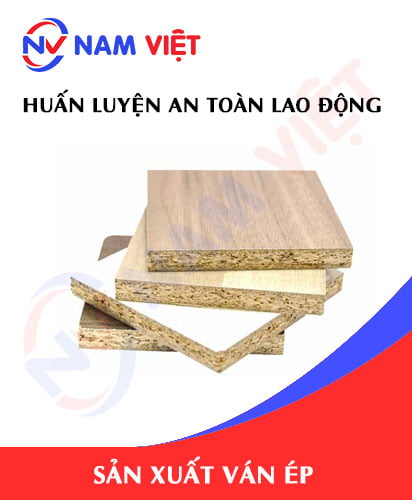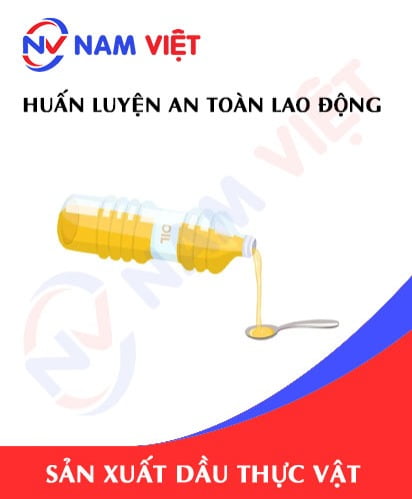Occupational Safety Training in Plywood Manufacturing Factory
99,000 ₫
Note: The above price is calculated for one person, the price may fluctuate depending on the number of trainees participating in the course and the movement of the market. For more accurate pricing support, please refer to the quotation table or contact our consulting staff directly.
Occupational safety is an important issue in plywood manufacturing factories and needs to be addressed promptly to ensure the health and safety of workers and enhance the reputation of enterprises. The Occupational Safety Training course is one of the effective solutions to raise awareness about preventing occupational accidents for workers when participating in plywood manufacturing.
Table of Contents
Toggle1. Overview of Plywood
a. What is Plywood?
- Plywood is a type of material manufactured by pressing thin layers of wood together with glue or other adhesives. The manufacturing process begins by cutting wood into thin, uniform sheets. The sheets are then stacked and glued together with glue or other adhesives.
- Each layer of wood is twisted and laid horizontally to create uniformity in both the size and durability of the plywood sheet. Finally, these wood sheets are pressed together with high pressure to create plywood with the necessary thickness and hardness. Plywood is widely used in the construction industry, furniture manufacturing, interior and exterior decoration, and other applications.
- According to the annual report of the Vietnam Wood and Forest Products Association, Vietnam’s plywood output reached over 4 million m3 in 2020, an increase of nearly 13% compared to the previous year. Along with that, export output also increased significantly, and Vietnam has become one of the leading plywood manufacturers and exporters in the Southeast Asia region.
- However, the plywood manufacturing industry is also facing many challenges such as difficulties in ensuring the source of wood materials, limited manufacturing techniques, low competitiveness, and the need for improvement in the manufacturing environment and labor safety issues. Therefore, to develop the plywood manufacturing industry sustainably, there needs to be cooperation between plywood manufacturing enterprises and government agencies to solve the above problems.

b. Types of Plywood Manufacturing Machinery
Types of plywood manufacturing machinery include:
- Wood sanding machine: A sanding machine is used to sand the surface of the wood, making the thin cut wood sheets more uniform and smooth.
- Gluing machine: A gluing machine is used to glue the wood sheets together with glue or other adhesives. The wood sheets will be arranged in order and placed horizontally before being put into the gluing machine.
- Pressing machine: A pressing machine is used to press the glued wood sheets together with high pressure, creating the necessary thickness and hardness for the plywood sheet. This machine can press and form different types of plywood.
- Plywood saw: A plywood saw is used to cut the wood sheets into different sizes and shapes according to customer requirements. The plywood saw can cut wood into thicker or thinner sheets.
- Surface smoothing machine: A surface smoothing machine is used to smooth the surface of the plywood sheet after it has been cut and shaped. This machine helps create smoother and more beautiful plywood products.
In addition, there are many other types of machinery used in the plywood manufacturing process such as hole sanders, wood grinders, balancers, exhaust gas treatment machines, heat presses, paint sanders, and shaping cutters.

c. Plywood Manufacturing Enterprises in Vietnam
Currently, there are many plywood manufacturing enterprises in Vietnam, including:
- Tan Tao Group (TTF)
- An Hoa Plywood Co., Ltd. (An Hoa Plywood)
- Quang Minh Plywood Co., Ltd. (Quang Minh Plywood)
- Saigon Plywood Co., Ltd. (Saigon Plywood)
- Phuoc Hoa Plywood Co., Ltd. (Phuoc Hoa Plywood)
- Hoang Phuc Plywood Co., Ltd. (Hoang Phuc Plywood)
- Xanh Plywood Co., Ltd. (Xanh Plywood)
- Minh Hoa Plywood Co., Ltd. (Minh Hoa Plywood)
- Phong Phu Plywood Co., Ltd. (Phong Phu Plywood)
- Vinaconex Plywood Co., Ltd. (Vinaconex Plywood)
In addition, there are many other different plywood manufacturing enterprises in Vietnam.
d. Specific Jobs in a Plywood Manufacturing factory
Group 1
- Executive director, deputy executive director, department head in a plywood manufacturing factory.
Group 2
- Safety officer: manages safety in the factory, designs safety procedures, supervises and urges employees to comply with safe work procedures.
Group 3
- Wood separation: The process of separating wood to clean and cut it into smaller sheets to be put into the plywood manufacturing stages.
- Drying: After being cut and processed, the wood is dried to reduce moisture. This makes the wood easier to use in plywood manufacturing.
- Glue processing: Glue is a very important component in the plywood manufacturing process. The glue is mixed and processed to ensure quality and durability.
- Plywood surface finishing: The process of finishing the plywood surface includes polishing, sanding, and painting. This helps protect the plywood from external impacts and provides durability to the product.
- Plywood pressing and cutting: The process of pressing and cutting plywood includes pressing glue and wood layers together to form a sheet. The sheet will then be cut and shaped to create products of different sizes and shapes.
- Quality inspection: During the manufacturing process, the plywood sheets will be quality checked to ensure they meet the standards and quality requirements of the customer.
- Packaging and transportation: Finally, the plywood products will be packaged and transported to retail locations or end customers.
Group 4
- Jobs in the office, service, sales, and marketing.
- Production management, quality management, human resource management, material management, financial and accounting management.
- Research and development of new products, design of product packaging.

2. Overview of the occupational safety training course for plywood manufacturing
Within the scope of this article, we focus on issues related to Group 3, because Group 3 is the group that directly participates in the manufacturing process and is exposed to the highest risk of occupational safety. Refer to other groups here
a. What is Group 3 occupational safety training?
- Occupational safety training for Group 3 is a series of lessons to equip workers with awareness on how to prevent occupational accidents.
- The occupational safety training course will help workers recognize and avoid dangers, and limit the risks of occupational accidents while working.
REGISTER FOR OCCUPATIONAL SAFETY TRAINING SERVICE
b. Training duration
Initial safety training duration
- The total training duration is at least 24 hours, including the examination time.
- 8 hours of theoretical study on the legal policy system on occupational safety and health
- 8 hours of theoretical study on basic knowledge of occupational safety and health
- 4 hours of theoretical study on specialized training content
- 2 hours of practical study on specialized training content
- 2 hours of theoretical examination at the end of the training course
The safety training center will divide the time into many training sessions depending on the time arrangement for the employees. But normally, there will be 6 training sessions, and the course will take place over 3 days, provided that the manufacturing enterprise can arrange continuous study time.
Periodic safety training duration
- Before the occupational safety card expires, if the employee wants to be re-certified, they must undergo a periodic occupational safety training course, with the periodic safety training duration being at least 50% of the initial safety training duration.
Explanation: The total duration of periodic occupational safety training is at least 12 hours, including the examination time. After completing the periodic training course and passing the required test, the employee will be re-certified and the occupational safety card will be renewed.
c. Content of the training course
| STT | TRAINING CONTENT | TRAINING DURATION (HOURS) | |||
| Total | In which | ||||
| Theory | Practice | Exam | |||
| I | System of policies and laws on occupational safety and health | 8 | 8 | 0 | 0 |
| 1 | Overview of the system of legal documents on occupational safety and health. | 6 | 6 | ||
| 2 | System of technical standards and regulations on occupational safety and health. | 1 | 1 | ||
| 3 | Specific regulations of state management agencies on occupational safety and health when newly constructing, expanding, or renovating works and facilities for manufacturing, using, preserving, storing, and inspecting types of machinery, equipment, materials, and substances with strict requirements on occupational safety and health. | 1 | 1 | ||
| II | Basic knowledge of occupational safety and health | 8 | 8 | 0 | 0 |
| 1 | Basic knowledge of dangerous and harmful factors in the workplace. | 4 | 4 | ||
| 2 | Methods to improve working conditions. | 1 | 1 | ||
| 3 | Safety culture in manufacturing and business. | 1 | 1 | ||
| 4 | Rights and obligations of employers and employees; policies and regimes on occupational safety and health for employees; functions and duties of the network of occupational safety and health staff. | 1 | 1 | ||
| 5 | Occupational safety and health rules, signs, safety and health instructions, and the use of safety equipment, personal protective equipment; first aid skills for occupational accidents, prevention of occupational diseases. | 1 | 1 | ||
| III | Specialized training content | 6 | 4 | 2 | 0 |
| General knowledge about types of machinery, equipment, and substances that generate dangerous and harmful factors; analysis, assessment, and management of occupational safety and health risks, safe working procedures with machinery, equipment, and substances with strict requirements on occupational safety and health. | 6 | 4 | 2 | ||
| IV | Safety training exam at the end of the training course | 2 | 2 | 0 | 0 |
| Total | 24 | 22 | 2 | ||
See more training content for 6 groups
d. Occupational safety card
After completing the occupational safety training course and passing the exam, the employee will be issued an occupational safety card (in practice, it is also called a Group 3 occupational safety certificate).
The Group 3 safety card will clearly show information such as: full name, date of birth, specific job and working environment. It also includes the training duration, a red seal and a signature confirming the completion of the training course.
According to the regulations for issuing safety cards specified in Clause 2 of Article 24 of Decree 44/2016/ND-CP, there are 2 cases:
- In the case that the employer and the employee have an employment contract, the employer must sign, seal, and laminate the safety card for the Group 3 trainee after they have undergone the training course from the occupational safety training unit and passed the exam.
- In the case of freelancers and seasonal workers who do not have an employment contract, the training unit must sign, seal, and laminate the safety card for the employee after they have undergone the occupational safety training course from the training unit and passed the exam.

3. Identifying hazards affecting workers in plywood manufacturing
The plywood manufacturing process can cause a number of hazards affecting the health of workers, including:
- The plywood manufacturing process often involves the use of glue and chemicals that can cause fires and explosions if not used correctly or stored safely.
- Machinery in the plywood manufacturing factory can cause injuries or accidents if not used correctly or not maintained periodically.
- Workers in the plywood manufacturing factory can get burned by chemicals, hot glue, or other materials used in the manufacturing process.
- If plywood is used in food-related products, there may be a risk of contamination from chemicals and allergens that can harm the health of consumers.
- The chemicals used in the plywood manufacturing process can pose a toxic risk to the health of workers if not used correctly or not protected properly.
- The plywood manufacturing process can also generate dust and smoke, which can harm the respiratory tract of workers if protective masks are not worn correctly.
- If electrical equipment in the factory is not regularly maintained, not properly insulated, or not waterproof, it will cause a risk of electric shock to workers during the manufacturing process.
4. Common types of occupational accidents for workers in plywood manufacturing
Common types of occupational accidents that occur during the plywood manufacturing process include:
- Accidents with machinery: When operating machinery during the plywood manufacturing process, workers can get stuck, cut, crushed, or bruised if they do not wear enough protective equipment such as safety shoes, helmets, masks, gloves, and body protection.
- Accidents with glue and chemicals: Workers can be burned or affected by chemicals, hot glue, or other materials used in the plywood manufacturing process.
- Accidents when lifting materials: Lifting heavy materials during the plywood manufacturing process can cause injuries such as broken bones, back pain, and accidents from slipping and falling.
- Accidents with electricity: Electrical sources in the plywood manufacturing factory can cause accidents from electric shock or fires and explosions.
- Accidents with dust and smoke: The plywood manufacturing process can also generate dust and smoke, which can harm the respiratory tract of workers.

5. Safety measures when participating in plywood manufacturing
To ensure occupational safety during the plywood manufacturing process, the factory needs to implement the following measures:
- Ensure the provision of sufficient protective equipment: The factory needs to provide sufficient protective equipment, including helmets, safety shoes, gloves, masks, safety glasses, noise-canceling headphones, and other protective equipment to protect workers from accidents and occupational diseases.
- Occupational safety training: The factory needs to train workers on occupational safety procedures, ensuring that all workers understand the safety regulations and measures.
- Periodic maintenance and inspection of manufacturing equipment: The factory needs to periodically maintain and inspect manufacturing equipment such as presses, saws, and slicing machines, ensuring they operate well and safely.
- Minimize contact with toxic substances: The factory needs to use equipment and techniques to minimize workers’ contact with toxic substances such as glue, chemicals, and dust.
- Ensure safety when lifting materials: The factory needs to ensure safety when lifting materials by using supporting equipment such as cranes and ensuring workers are trained to lift materials correctly.
- Control fire and explosion status: The factory needs to have an effective fire and explosion control system and ensure that workers are trained to handle emergency situations in case of an incident.
- Control noise level: The factory needs to control the noise level to protect the health and hearing of workers, including using earplugs and noise-canceling headphones.
- Periodically organize work environment monitoring in the factory, collect and analyze harmful factors for workers, thereby adjusting and reducing the level of harm to prevent occupational diseases for them.
6. Benefits of occupational safety training for plywood manufacturing
An Toan Nam Viet provides businesses with great benefits after completing the occupational safety training courses as regulated in Decree 44/2016/ND-CP on occupational safety and health work, for companies, enterprises.
- Employees can recognize the potential risks of occupational accidents and take preventive measures to avoid occupational accidents.
- Your business can establish risk prevention measures in the manufacturing, operation, and maintenance process.
- Minimize costs when there is a risk of occupational safety loss.
- An uninterrupted manufacturing process will help increase labor productivity and product quality.
- Comply with occupational safety laws, avoiding legal risks.
- Create credibility and professionalism in all aspects, thereby enhancing your business’s brand.
Nam Viet’s training courses are the solution to prevent and combat external factors affecting each individual so that they can avoid dangers that can lead to injury or, more seriously, death.
REGISTER FOR OCCUPATIONAL SAFETY TRAINING SERVICE
7. Customer feedback after completing the occupational safety training course for plywood manufacturing
An Toan Nam Viet has many years of experience in the mission of accompanying many businesses in Vietnam in general and in the southern provinces in particular. And that responsibility to Nam Viet is something extremely valuable, which is why Nam Viet’s Occupational Safety Training work is increasingly focused on becoming more professional. The motivation for An Toan Nam Viet to grow strongly to this day comes from the positive feedback and suggestions from businesses. Below is the feedback from our partners that we have served.
Bac Nam E&C Construction Investment Joint Stock Company
“The first time I used An Toan Nam Viet’s service, I was very surprised by the enthusiastic 24/7 support from the consulting team. The class organization was very quick and convenient for our company, thank you very much for Nam Viet’s service!”
Hoa Dat Construction and Trading Joint Stock Company
“Nam Viet’s service has helped us a lot in simplifying work safety and the process of completing safety records to serve our work. The consulting team is enthusiastic and timely in answering our questions. 5 stars for Nam Viet”
See more customer interviews after using An Toan Nam Viet’s services
8. An Toan Nam Viet’s Occupational Safety Training Capability
An Toan Nam Viet is a reputable and quality occupational safety training center in Vietnam today. With continuous occupational safety training sessions held at manufacturing workshops, factories or construction sites across the country (63 provinces and cities in Vietnam).
REGISTER FOR OCCUPATIONAL SAFETY TRAINING SERVICE
Occupational safety training license
- An Toan Nam Viet has been inspected by the Department of Labor Safety of the Ministry of Labor – Invalids and Social Affairs and granted a certificate of eligibility to operate occupational safety and health training. This further strengthens our occupational safety training capability.

Documents and lectures
- Before the occupational safety training documents are put into the occupational safety training courses, they have been reviewed and censored to ensure that the lectures are always correct in terms of knowledge and effective when applied.
- The teaching method of the lecturers is synchronized according to An Toan Nam Viet’s teaching standards, which is a method that experts on occupational safety and health training have researched and drawn from the teaching process to bring the highest knowledge acquisition efficiency to students.
Facilities
- Controlling the factors in the classroom that affect the training process will increase the teaching performance and the knowledge acquisition efficiency of the students.
- Our facilities supporting the training course always have spacious classrooms that meet the standards for area, lighting, training equipment … etc.
9. Reputable and quality safety training center nationwide
At An Toan Nam Viet, we always put the professional dedication to occupational safety training as our top priority. For us, imparting the knowledge of self-protection to workers so that they can have a safe foundation on their livelihood journey is a contribution to building the country.
To ensure effective training, we prepare carefully and meticulously every little detail, no matter how small. From preparing tools, equipment, teaching equipment to curriculum, documents, sound, and lighting.
Our occupational safety training lecturers are experts with many years of experience in the field. They even have research projects identifying the hazards in all occupations and how to prevent them.
The lecturer’s lectures are drawn from reality and conveyed in a vivid, easy-to-visualize way to the workers. These factors help workers feel comfortable during their study time and acquire our teaching knowledge well. Of course, the knowledge conveyed always closely follows Decree 44/2016/ND-CP.
From there, they grasp many measures to prevent dangers and how to protect themselves. At the same time, they also apply it in the most appropriate way in real-life work.
Our safety training center is proud to be a reputable and professional provider of occupational safety training services with the following advantages:
- Competitive training costs but guaranteed training quality.
- Flexible training schedule to suit the manufacturing situation of the company.
- Fast and legally compliant procedures for occupational safety training certificate issuance.
- Training lecturers are people with many years of experience in the profession.
- The classroom is controlled for factors affecting the training process, increasing teaching performance and the knowledge acquisition efficiency of the students.
- The lectures are compiled to be suitable for occupational safety work in enterprises.
- An Toan Nam Viet works dedicatedly and professionally to support customers accurately and as quickly as possible.

10. Refer to more occupational safety training documents for plywood manufacturing
- Occupational safety documents for plywood manufacturing
- Set of occupational safety training documents
- Set of occupational safety training exam questions
- Occupational safety multiple-choice test for plywood manufacturing
- Slides of occupational safety lectures for plywood manufacturing
11. Occupational safety training activities for plywood manufacturing
1 review for Occupational Safety Training in Plywood Manufacturing Factory
No comments yet















namchinh.haiphong341
Dịch vụ huấn luyện an toàn lao động rất tốt nhé, giảng viên dạy rất sinh động dễ hiểu!